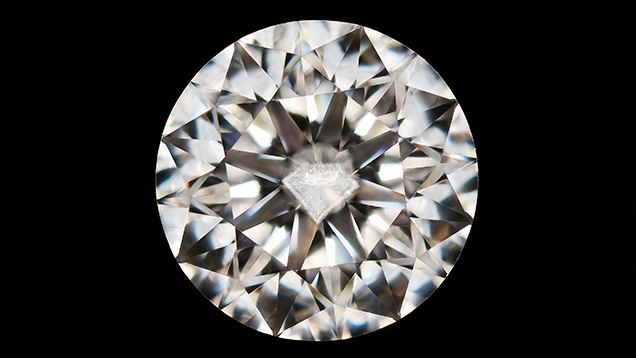Diamond-Shaped Cloud in Diamond

Diamonds can show some interesting surprises when examined by microscopy. Recently, the authors examined a D-color, 0.53 ct round brilliant diamond with an intriguing cloud inclusion that bore a remarkable resemblance to the profile view of a faceted round brilliant (figure 1). Due to the prominent diamond-shaped cloud under the table, the clarity grade of the stone was SI2 (figure 2).

Photomicrography was used to chronicle the depth of the cloud, which indicated that it was three-dimensional and part of its center reached the diamond’s surface. When focusing through the inclusion beginning at the surface of the table facet, the cloud spanned ~320 microns of focal distance. This is not the first instance of a faceted diamond showing a cloud inclusion with diamond-related geometry. Gemologists have shown other natural diamonds with clouds resembling diamond octahedra (Winter 2015 Lab Notes, pp. 428–429; Renfro et al., Winter 2018 G&G, pp. 428–429). However, this is the first cloud with such a shape the authors have encountered.
The infrared absorption spectra showed a type Ia diamond with saturated concentrations of nitrogen. Photoluminescence maps were collected with 532 nm and 455 nm excitation. A false-color map corresponding with the normalized intensity of a peak at 700 nm (figure 3A) was detected almost solely within the cloud. This peak at 700 nm has been ascribed to nickel and can be seen in hydrogen-rich diamonds, particularly within hydrogen-rich clouds (e.g., Fall 2020 Lab Notes, pp. 416–419).
In the 455 nm PL map, we detected the H3 center at 503.2 nm (figure 3B), which is identified as an A-aggregate decorated with a vacancy. The especially dense area along the “girdle” showed a distinct chemistry as that portion of the cloud had an elevated 700 nm peak intensity (figure 3A) and an elevated H3 concentration (figure 3B). Figure 3C shows the intensity of the diamond Raman peak. The Raman signal detected within the cloud shows decreased intensity; additionally, the diamond outline in this map corresponds well with the image in figure 1 (as the presence of the cloud reduces the Raman signal reaching the detector). Prior research has shown that oftentimes such clouds form preferentially within the {100} growth sectors (W. Wang and W. Mayerson, “Symmetrical clouds in diamond – the hydrogen connection,” Journal of Gemmology, Vol. 28, No. 3, 2002, pp. 143–152).

While this diamond-shaped cloud formation may cause some concern over the natural origin of such an inclusion (see an example of a 3D subsurface laser engraving in quartz in Fall 2020 Micro-World, pp. 427–430), the cloud in this diamond appeared to be completely natural when examined in the microscope. Generally, the absence of inclusions or clarity characteristics increases the beauty and value of a diamond, but not always. In this diamond, the cloud’s presence adds beauty, value, and distinction. Thanks to an observant and skillful polisher, we get to see another “brilliant” example of an intriguing cloud inclusion in diamond.



